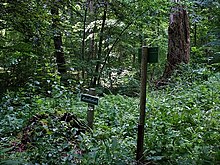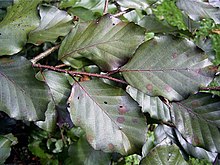Copper beech
| Copper beech | ||||||||||||
|---|---|---|---|---|---|---|---|---|---|---|---|---|

Copper beech group on Ostparkstrasse in Frankfurt am Main |
||||||||||||
| Systematics | ||||||||||||
|
||||||||||||
| Scientific name | ||||||||||||
| Fagus sylvatica f. purpurea | ||||||||||||
| Aiton |

The copper beech , ( Fagus sylvatica f. Purpurea ), also called purple beech , so called because of its reddish leaves, is a mutation of the common beech . Both belong to the same species Fagus sylvatica and thus to the genus beeches ( Fagus ) from the beech family (Fagaceae).
“A very strange variety of the European beech is the so-called copper beech, which differs from that only in its foliage, which is fiery red in the spring, but turns reddish brown towards autumn. The ancestral mother of this beech is in the forest near Sondershausen. "
Copper beeches have been known since the 15th century, originally under the name Fagus sylvatica f. atro-punicea . The so-called mother blood beech comes from the Possenwald near the city of Sondershausen in Thuringia . Their culture began in the Principality of Schwarzburg-Sondershausen all over the world and is a popular park tree.
Of this natural variety or shape of the beech (the abbreviation f. In the name stands for shape) there are also various varieties that can be traced back to targeted breeding, such as Swat Magret and Riversii .
description
The red color is one of the lack enzyme due, which normally only in the epidermis of young leaves occurring anthocyanins degrades. The epidermis of the leaf is no longer transparent, but reddish in color and the leaf green inside the leaf is no longer visible. Copper beeches lose their red color over the course of the vegetation period , they gradually turn green and are barely recognizable as copper beeches to the casual observer in autumn. Sun leaves usually contain more anthocyanins than shadow leaves , which are greener.
Copper beeches, like all European beeches, can reach a height of 30 m and live for over 200 years.
origin
The copper or purple beech can be traced back to a mutation of a common beech. Around 99 percent of all specimens that exist today are said to go back to the mother beech from 1690 from the Possenwald on the Hainleite near the Thuringian city of Sondershausen. The so-called 11 sisters , where the breeding of the copper beeches was started, had sprouted around the tree . The plant found interest throughout Europe, so that u. a. also a very early descendant was to be found in London's Hyde Park and from there the copper beech has spread further.
Under the hunting and forest enthusiast Prince Günther Friedrich Carl II of Schwarzburg-Sondershausen (1801–1889), Eduard Michael, who was employed as a forester in 1823, examined the mother tree. In 1841 it was published that the original tree at that time was 27 meters high and 80 (measured from east to west) or 85 centimeters (from north to south). From the 1860s onwards, Michael, as chief forest master, sent seeds and edible vines from Sondershausen to other forest offices, gardeners and private individuals. This means that the systematic breeding and spread of the copper beech did not begin until the 19th century. The trade was worldwide u. a. expanded to France, England and America.
The largest stocks of copper beeches are said to be in Scotland.
The mother beech itself still existed until it was demolished in 1926. Today, on the blood beech hiking trail to Oberspier, a sign on the heavily weathered stump reminds of the place of origin. In the immediate vicinity is the even better preserved remnant of one of the sister trees.
Systematics
The copper beech is a form of the common beech from the beech genus ( Fagus ) and belongs to the beech family (Fagaceae).
Other forms of beech with a special growth, such as hanging beech or Süntel beech , were crossed with copper beech. For example, there are:
- Blood-hanging beeches ( Fagus sylvatica cv. 'Pendula Purpurea')
- Blood-Süntel-Buchen ( Fagus sylvatica cv. 'Tortuosa Purpurea')
Others
heraldry
The Swiss municipality of Buch am Irchel has a copper beech in its coat of arms. This represents the copper beech, documented since 1680, on the Stammberg, a small wooded elevation.
literature
- Gerhard Dönig: The park and garden forms of the red beech - Fagus sylvatica L. garden picture , Rinteln 1994, ISBN 3-928521-05-5 .
Individual evidence
- ^ Heinrich Wilhelm Döbel: Heinrich Wilhelm Döbel's newly opened hunter internships . Gleditsch, Leipzig 1828.
- ↑ Forest wilderness antics: mother blood beech should be brought more into focus. In: Kyffhauser news. July 5, 2017, accessed February 10, 2019 .
- ↑ Hanna Nagel: On the cultivation and distribution of the copper beech from the Principality of Schwarzburg-Sondershausen . In: Sondershäuser Heimatecho vol. 29 No. 12, Sondershausen: Starke 2018, p. 25 f.



